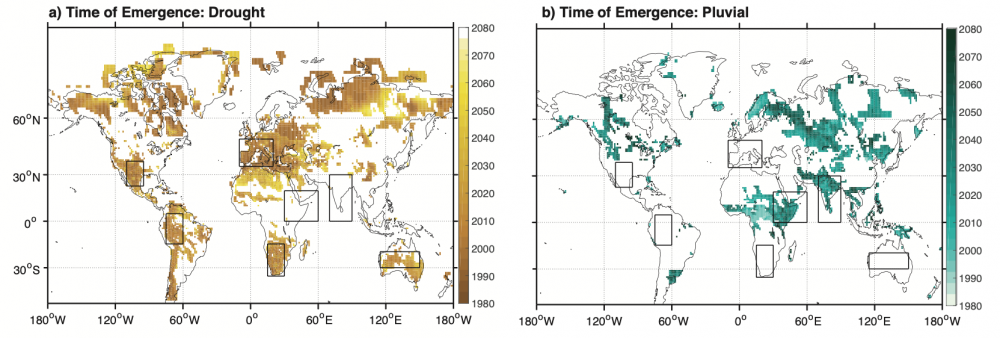Over the past 20 years, the maps of the American West have presented ever darker hues of red. The colors show the unparalleled drought ruining the region. In certain regions, conditions have gone past harsh and extreme drought into incomparable drought. But instead of adding more superlatives, one team of researchers believes it is time to redefine the term drought.
 These maps indicate the year in which average conditions in different regions will cross the threshold of megadrought (left) or megapluvial (right) under our current definitions. Image Credit: STEVENSON ET AL.
These maps indicate the year in which average conditions in different regions will cross the threshold of megadrought (left) or megapluvial (right) under our current definitions. Image Credit: STEVENSON ET AL.
Scientists from half a dozen universities explored what the future might be like regarding soil moisture and rainfall, two variables used to measure drought. The team, headed by the University of California, Santa Barbara’s Samantha Stevenson, found that a number of areas around the world will go into permanent wet or dry conditions in the future decades, under contemporary definitions.
The findings, reported in the Proceedings of the National Academy of Sciences, present the significance of rethinking how these events are classified as well as how to react to them.
Essentially, we need to stop thinking about returning to normal as a thing that is possible.
Samantha Stevenson, Study Lead and Assistant Professor, Bren School of Environmental Science and Management, UC Santa Barbara
This concept impacts both how drought and pluvial (unusually wet) events are defined and how humans adapt to a shifting environment.
A drought is when the environment is drier than anticipated. But this idea becomes unclear when the baseline itself varies. Stevenson proposes that, for certain applications, it is more useful to define drought relative to this varying background state, instead of a region’s past range of water availability.
To estimate future soil moisture and rainfall levels, Stevenson and her colleagues looked at a new range of climate models from various research organizations. Scientists had applied each model several times with marginally different preliminary conditions, in what researchers term an “ensemble.” Since the climate is an innately chaotic system, scientists use ensembles to account for a few of these irregularities.
The results demonstrate a world where some regions are in perpetual drought while others endure perennial pluvial for the remaining part of the 21st century. The researchers assessed the year wherein average soil moisture will surpass the threshold that describes either a megapluvial or a megadrought.
In other words, at what point do average conditions exceed what we would consider a megadrought if it happened now, [and never return to ‘normal’].
Samantha Stevenson, Study Lead and Assistant Professor, Bren School of Environmental Science and Management, UC Santa Barbara
The American West has already gone past this level, and there are other regions going in the same direction, including southern Africa, Australia and western Europe.
“But, again, that’s if we use today’s definition of a drought,” Stevenson said.
The researchers debate that there is a need to shift from fixed definitions toward a more refined account of pluvial and drought.
“Our idea of normal is, in a sense, meaningless when ‘normal’ is continuously changing,” Stevenson added.
Climate models specify that average soil moisture in a number of regions will continue to decline. That said, the team’s ensembles propose that soil moisture will continue to endure drought-related variation akin to the present-day, compared with the ever-drier baseline.
The variation emphasizes the need to take into consideration both long-term variations and the usual pros and cons related to historic pluvials and droughts.
The most important management challenge will be to adjust for the relentless declines in water availability, as this exceeds the expected impact of future megadroughts,
Julia Cole, Study Co-Author and Professor, University of Michigan
On the other hand, rainfall patterns will become a lot more extreme. Warm air contains more moisture than cold air. So as the air heats up, it will be able to absorb more moisture from dry areas and dump more rainfall on wet areas.
“We wanted to consider both precipitation and soil moisture at the same time because that can be important for water management,” Stevenson said.
For example, there will be a need to adjust infrastructure to handle more arid situations in the western United States, but that infrastructure will also have to manage more extreme rainfall.
When we talk about being in a drought, the presumption is that eventually the drought will end, and conditions will return to normal. But if we’re never returning to normal, then we need to adapt all of the ways that we manage water with the expectation that normal will continually be drier and drier every year.
Samantha Stevenson, Study Lead and Assistant Professor, Bren School of Environmental Science and Management, UC Santa Barbara
Journal Reference:
Stevenson, S., et al. (2022) Twenty-first century hydroclimate: A continually changing baseline, with more frequent extremes. Proceedings of the National Academy of Sciences. doi.org/10.1073/pnas.2108124119.